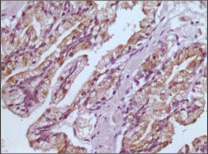GSTP1 Monoclonal Antibody
- Catalog No.:YM0320
- Applications:WB;IHC;IF;FCM;ELISA
- Reactivity:Human
- Target:
- GSTP1
- Fields:
- >>Glutathione metabolism;>>Metabolism of xenobiotics by cytochrome P450;>>Drug metabolism - cytochrome P450;>>Drug metabolism - other enzymes;>>Metabolic pathways;>>Platinum drug resistance;>>Pathways in cancer;>>Chemical carcinogenesis - DNA adducts;>>Prostate cancer;>>Hepatocellular carcinoma;>>Fluid shear stress and atherosclerosis
- Gene Name:
- GSTP1
- Protein Name:
- Glutathione S-transferase P
- Human Gene Id:
- 2950
- Human Swiss Prot No:
- P09211
- Mouse Swiss Prot No:
- P19157
- Immunogen:
- Purified recombinant fragment of human GSTP1 expressed in E. Coli.
- Specificity:
- GSTP1 Monoclonal Antibody detects endogenous levels of GSTP1 protein.
- Formulation:
- Liquid in PBS containing 50% glycerol, 0.5% BSA and 0.02% sodium azide.
- Source:
- Monoclonal, Mouse
- Dilution:
- WB 1:500 - 1:2000. IHC 1:200 - 1:1000. IF 1:200 - 1:1000. Flow cytometry: 1:200 - 1:400. ELISA: 1:10000. Not yet tested in other applications.
- Purification:
- Affinity purification
- Storage Stability:
- -15°C to -25°C/1 year(Do not lower than -25°C)
- Other Name:
- GSTP1;FAEES3;GST3;Glutathione S-transferase P;GST class-pi;GSTP1-1
- Molecular Weight(Da):
- 23kD
- References:
- 1. Kimihiko Satoh, Ken Itoh, Masayuki Yamamoto. 2002. Carcinogenesis. 23: 457 - 462.
2. Xiaohui Lin,William G. Nelson.2003.Cancer Research. 63: 498-504.
- Background:
- Glutathione S-transferases (GSTs) are a family of enzymes that play an important role in detoxification by catalyzing the conjugation of many hydrophobic and electrophilic compounds with reduced glutathione. Based on their biochemical, immunologic, and structural properties, the soluble GSTs are categorized into 4 main classes: alpha, mu, pi, and theta. This GST family member is a polymorphic gene encoding active, functionally different GSTP1 variant proteins that are thought to function in xenobiotic metabolism and play a role in susceptibility to cancer, and other diseases. [provided by RefSeq, Jul 2008],
- Function:
- catalytic activity:RX + glutathione = HX + R-S-glutathione.,function:Conjugation of reduced glutathione to a wide number of exogenous and endogenous hydrophobic electrophiles.,online information:The Singapore human mutation and polymorphism database,similarity:Belongs to the GST superfamily. Pi family.,similarity:Contains 1 GST C-terminal domain.,similarity:Contains 1 GST N-terminal domain.,subunit:Homodimer.,
- Subcellular Location:
- Cytoplasm . Mitochondrion . Nucleus . The 83 N-terminal amino acids function as un uncleaved transit peptide, and arginine residues within it are crucial for mitochondrial localization.
- Expression:
- Brain,Cajal-Retzius cell,Colon carcinoma,Fetal brain cortex,Platelet,Urinar
- June 19-2018
- WESTERN IMMUNOBLOTTING PROTOCOL
- June 19-2018
- IMMUNOHISTOCHEMISTRY-PARAFFIN PROTOCOL
- June 19-2018
- IMMUNOFLUORESCENCE PROTOCOL
- September 08-2020
- FLOW-CYTOMEYRT-PROTOCOL
- May 20-2022
- Cell-Based ELISA│解您多样本WB检测之困扰
- July 13-2018
- CELL-BASED-ELISA-PROTOCOL-FOR-ACETYL-PROTEIN
- July 13-2018
- CELL-BASED-ELISA-PROTOCOL-FOR-PHOSPHO-PROTEIN
- July 13-2018
- Antibody-FAQs
- Products Images

- Western Blot analysis using GSTP1 Monoclonal Antibody against PC3 cell lysate (1) and human cerebellum tissue lysate (2).

- Immunohistochemistry analysis of paraffin-embedded human prostate tissues with DAB staining using GSTP1 Monoclonal Antibody.

- Confocal immunofluorescence analysis of HepG2 (left) and L-02 (right) cells using GSTP1 Monoclonal Antibody (green). Red: Actin filaments have been labeled with DY-554 phalloidin. Blue: DRAQ5 fluorescent DNA dye.

- Flow cytometric analysis of K562 cells using GSTP1 Monoclonal Antibody (green) and negative control (purple).



